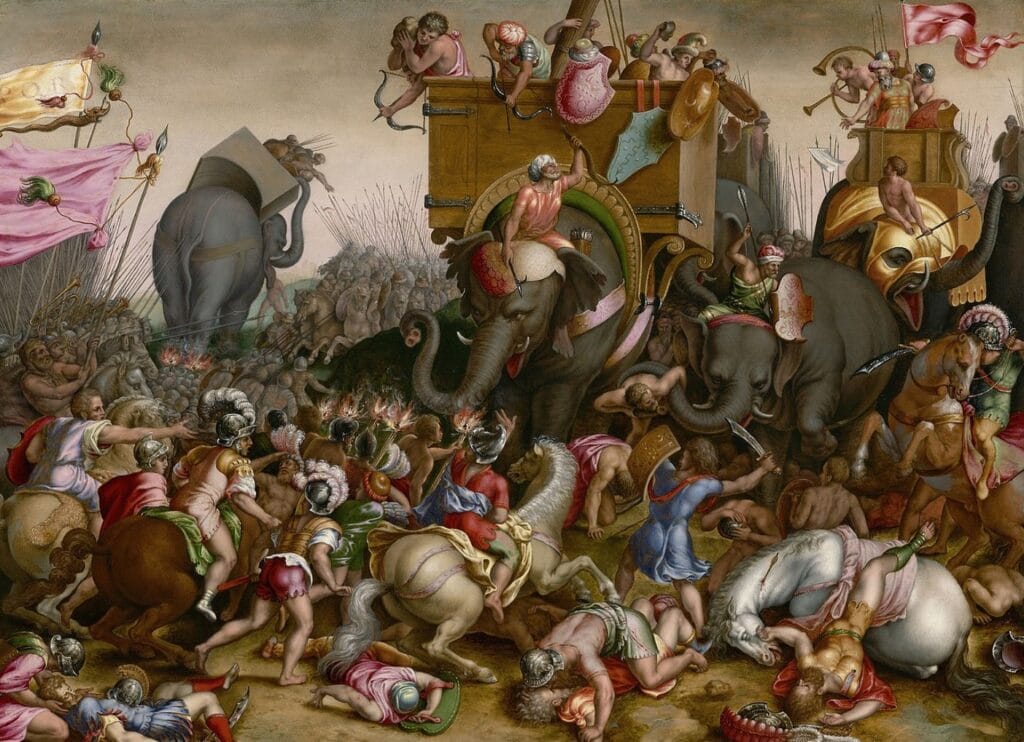
The Battle of Zama in the summer of 202 BC marked the end of the power of the great Hannibal Barca.
With its greatest son, also Carthage should be at a virtual end. True, it should limp on for some time, but with its defeat at the end of the Second Punic War it no longer was a significant power.
Zama also marks the pinnacle in the career of the outstanding Roman general Publius Cornelius Scipio, whose reforms to the Roman army made him legendary.
The Second Punic War took a turn as Roman forces finally landed in Africa and began marauding the area, defeating the Carthaginian armies under Syphax and supporting a Numidian rising against Carthaginian rule. Carthage was ready to sue for peace when Hannibal with 15’000 veterans returned from Italy. Emboldened by the return of its great hero at its our of need Carthage continued to war.
Despite his veterans, Hannibal though was not in an ideal position. Syphax’ forces having been destroyed he had to raise a new army in order to deal with the extra-ordinary challenge which lay ahead.
Just as at Cannae, the Roman meeting with Hannibal was to be of huge scale. As they met near Zama Regia in the summer of 202 BC, both armies numbered 35’000 to 40’000 men. Hannibal now had a strong elephant corps with him, but his infantry were of lesser quality to the highly trained legions of Scipio. Further Scipio had an advantage in cavalry, having delayed an engagement for long enough to allow for a strong Numidian force under Masinissa to join him.
1. The Armies meet
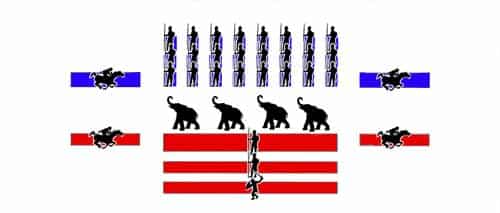
The Romans drew up their forces in three lines, creating an effective reserve in the rear. The maniples however stood in separate formations, not creating a continuous line. The gaps were loosely filled by the velites (skirmishers).
The Roman left wing was made up of Italian allied cavalry, while the right wing consisted of the Numidian calvary of Massinissa.
Hannibal meanwhile also aligned his troops in three lines. His mercenaries took the front, the second line was formed by the Carthaginian forces and those of the Carthaginian territories (Liby-Phoenicians). Finally at the rear stood Hannibal’s most reliable troops, the veterans from the campaign in Italy.
At the very front of the army Hannibal placed his elephant corps.
On his left wing he had his Numidian cavalry and to the right stood the Carthaginian cavalry.
2. The Elephants charge
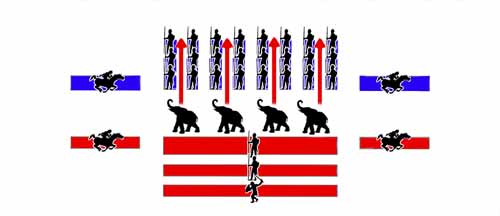
After some initial skirmishes between the cavalry units, the battle began with a charge of the Carthaginian war elephants.
They were meant to cause confusion and terrify the enemy. But it was here that Scipio’s preparation in lining up his troops in separate maniples bore fruit. The velites in the gaps now engaged the elephants, drawing them up through the alleys between the main Roman units. Also Scipio had ordered for every trumpeter of the army to blow, creating a startling noise which terrified the nervous beasts. This Roman tactic was largely successful. Most of the elephants simply charged up the alleys between the units, others even turned and collided with their own cavalry. However some did indeed drive into the Roman ranks and caused considerable damage before escaping up the alleys. Had Scipio not found a means by which to deal with the Carthaginian elephant corps, it indeed might have been his undoing.
3. The Roman Cavalry charges
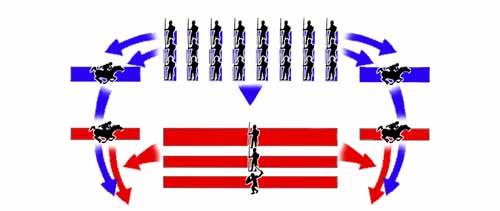
It was in the confusion immediately following the charge of the elephants that the Roman cavalry decided to launch its attack. The Carthaginian cavalry crumbled under the charge and fled, being pursued by the Romans.
Scipio will not have been much pleased with the departure of his own cavalry. Having driven the enemy away, he no doubt counted on them to attack the flanks of the main Carthaginian body, instead of pursuing a fleeing foe. But nonetheless, Scipio remained calm, knowing himself with the superior infantry force.
Both sides gradually advanced on each other, until the Romans charged. The initial charge was quite competently halted by the Hannibal’s mercenaries in the front line, but soon the Roman discipline began to win over and started to force the Carthaginian line to give ground.
The Carthaginian second line though failed to give any support and when the mercenaries tried to fall back the second line actually levelled their weapons on them, causing some of the mercenaries to actually turn on their own side and begin attacking the line behind them.
As the pressure from the advancing Romans grew Hannibal’s veterans stood firm, forcing the mercenaries and regular Carthaginian troops to the sides instead of throwing the veteran line into disorder. Hannibal’s veterans were no doubt among the best troops in the world at that time and they caused a significant impact on the center of a tired Roman line when the lines met.
Scipio in response to the sideways move of the Carthaginian front rows, moved his principes to the sides and their triarii to the very flanks to give his army more width and prevent the Carthaginians from outflanking him.
For a time the battle hung in the balance.
4. The Cavalry returns
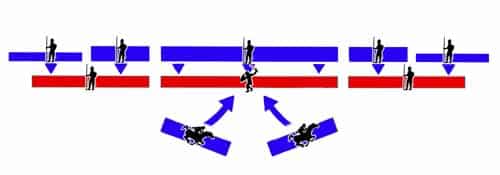
Now the Roman cavalry, having driven the fleeing Carthaginian horse away, returned and immediately fell into the rear of the Carthaginian lines.
This decided the battle and at once Hannibal’s army began to collapse.
Had Scipio been unable to defeat Hannibal in a pure infantry engagement, his superior cavalry did the job for him.
Scipio’s critics would argue that he did not so much outwit Hannibal, as merely copy his tactics in extending the line of battle and allow for his superior troops to do the damage.
However, Scipio was in the stronger position. His role was merely that of defending his advantage and letting his side’s superiority do the work. The pressure was on Hannibal to produce some surprising tactic by which he could once again swing the odds in his favour.
But with a commander such as Scipio the Roman army was a yet fiercer foe than it had been at Cannae. And this time the odds were simply too great.
There has been a traditional simplifying view that Hannibal encircled his enemy at Cannae and was defeated by the same tactics at Zama. This though proves to be incorrect. Hannibal was not outgeneraled at Zama. For Scipio won the battle of Zama by winning the cavalry duel, due to superior numbers.
Thereafter his legions could not defeat the Carthaginian infantry, but needed to wait for the return of the cavalry.
Scipio’s respect for his dangerous foe is shown in the simplicity of his manoeuvres. Had he at Ilipa shown elaborate manoeuvres against the Carthaginian commander Hasdrubal, then with Hannibal he merely reacted, keeping his reserves at the rear, waiting for Hannibal’s moves.
If there is an irony in Hannibal’s defeat at Zama though, it is that he was vanquished by the very thing he had sought to provoke with his invasion of Italy. Had he sought to inspire the tribes of Italy to rise against Roman rule, he had failed. Yet it was exactly the addition of the rebel Masinissa’s Numidian cavalry to Scipio’s forces which effectively sealed Hannibal’s defeat.
If to Carthage the Battle of Zama meant the end of their empire, then to Rome it was also a significant event. Not only had they vanquished a dangerous and able opponent and gained valuable territories, but their armies had now proven their superiority in battle against highly skilled and sophisticated foes.
Had Cannae exposed Roman tactics as primitive, then Scipio’s reforms had turned his army into a fighting machine which could match even commanders as great as Hannibal.
The Roman army had mastered tactics and now could begin with its near-unstoppable conquest of the civilized world.
FAQ: Battle of Zama
1. What was the Battle of Zama?
The Battle of Zama, fought in 202 BCE, was a significant and decisive engagement in the Second Punic War between Rome and Carthage. It marked the end of the war, with a Roman victory led by General Scipio Africanus.
2. Where did the Battle of Zama take place?
The battle occurred near Zama, which is present-day Tunisia in North Africa.
3. Who were the key figures in the Battle of Zama?
The main commanders were Scipio Africanus for the Roman side and Hannibal Barca for the Carthaginians.
4. What was the significance of elephants in the Battle of Zama?
Hannibal famously used war elephants in the battle, though they proved to be ineffective against the well-prepared Roman troops.
5. How did the Battle of Zama end?
The battle concluded with a comprehensive Roman victory, largely due to Scipio’s strategic brilliance and the disciplined Roman legions.
6. What were the consequences of the Battle of Zama for Carthage?
The defeat led to Carthage losing its status as a major power, significantly reduced territories, and heavy war indemnities to Rome.
7. How did the Battle of Zama influence Roman history?
The victory solidified Rome’s position as the dominant power in the Western Mediterranean and paved the way for its transition into an imperial power.
8. Are there any notable historical sources about the Battle of Zama?
Primary sources include accounts by Livy and Polybius, ancient historians who provided detailed descriptions of the battle.
9. Has the exact location of the Battle of Zama been identified?
The precise location remains a topic of debate among historians, with several proposed sites but no definitive conclusion.
10. How is the Battle of Zama remembered in modern times?
It is remembered as a turning point in ancient military history and is often studied for its strategic and tactical innovations.
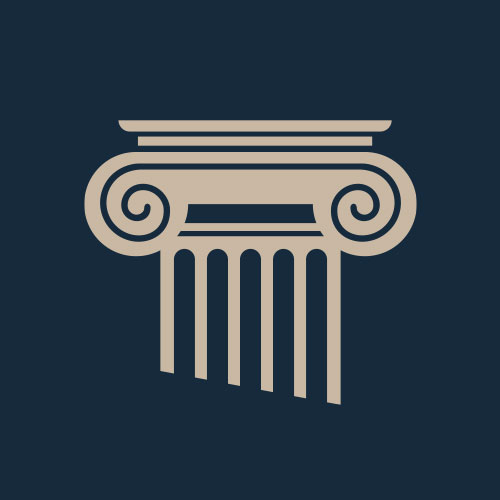
Historian Franco Cavazzi dedicated hundreds of hours of his life to creating this website, roman-empire.net as a trove of educational material on this fascinating period of history. His work has been cited in a number of textbooks on the Roman Empire and mentioned on numerous publications such as the New York Times, PBS, The Guardian, and many more.
